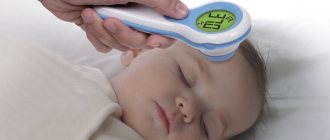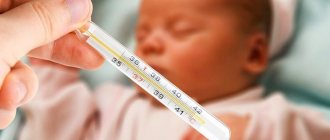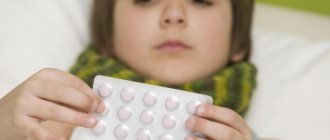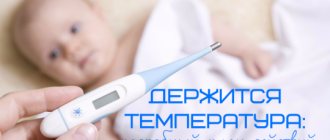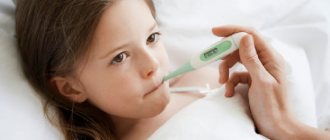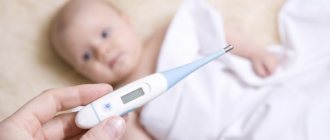Causes of temperature 37
A child’s temperature can reach 37 degrees for a number of the following reasons:
- Baby overheating. This often happens when caring mothers wrap their child in too warm clothes (and the room is already quite hot). As a result, the body overheats, the baby’s face turns red and the fever rises.
- Dysbacteriosis. When beneficial microorganisms die in the intestines, giving way to pathogenic microflora, the baby experiences a deterioration in appetite, a slight fever and bowel dysfunction. Analyzes will help clarify the situation.
- Protein complementary foods. When a child begins to be given a lot of protein foods at the complementary feeding stage (eggs, mashed meat, cottage cheese, etc.) and the baby consumes little water, this can subsequently lead to the development of protein fever and an increase in body temperature to 37-37.5 degrees .
If an increase in temperature is accompanied by symptoms such as cough, runny nose, diarrhea and vomiting, you can assume either a cold or an intestinal infection.
Features of thermoregulation in newborns
Immediately after birth, the child’s body begins to actively adapt to the environment. The baby learns to see, hear, and digest new food. In my mother’s stomach, all these functions were turned off, and there was no need to adapt to changes in air temperature. It takes some time for all body functions to be regulated and improved.
The thermoregulation mechanism of an adult person works automatically: in hot weather the body cools down with sweat, in severe frost a person is warmed by subcutaneous fat and muscle tremors. In a 1-month-old child, these mechanisms are not established and do not work. The baby cannot sweat, cannot protect itself from the cold by trembling. The baby's body temperature can range from 36.4 to 37.2. These indicators are considered normal.
Note! With prolonged crying, the newborn's body temperature may rise sharply, but after calming down it becomes normal again.
Overheating of the body is especially dangerous for children. If a child can still protect himself a little from the cold with the help of active movements of his limbs, then he cannot protect himself from overheating. Therefore, children in the first year of life may experience heat strokes. Babies do not have subcutaneous fat, which is why any changes in the external environment can negatively affect their well-being. A baby can easily overheat in a hot room or freeze if the temperature drops slightly.
The process of formation of thermoregulation reaches stabilization only in the fifth month of life, and before the fifth month, variability in body temperature is considered normal. Therefore, young mothers should not be scared when they see the thermometer rise: if the child behaves actively, it means he is not sick. A good appetite is also considered an indicator of health. For about a month, a temperature of 37 is the natural state of a baby.
Is it necessary to reduce this temperature?
It is not recommended to lower the temperature within 37-37.5 degrees, since in the first weeks and even months of life this phenomenon is absolutely normal and should not cause great concern (of course, in the absence of other alarming symptoms: bowel dysfunction, cough, persistent runny nose etc.). The only thing that can be done is to change the baby into lighter clothes made from natural fabrics (cotton or linen) and ventilate the children's room as much as possible.
It is also recommended to do wiping with water at room temperature. But at the same time, it is important to take precautions so that the child does not catch a cold (close the windows first, avoid any drafts in the room).
Signs of overheating
When overheated, the newborn becomes lethargic and refuses to eat. The neck becomes covered with heat rash, body temperature rises sharply - it can reach 39. This is a very dangerous condition for the baby, and the only protection is sleep. The child falls into an anxious, long sleep.
What should be done in this case? Immediately undress the baby and give him some water or milk, then check what the temperature is. The danger of overheating is dehydration, which can lead to serious consequences. If the child's body temperature does not decrease, call the pediatrician.
When walking in the heat, hot air may stagnate under the stroller canopy. Pay attention to this! It’s better to fold the visor and open an umbrella from the sun. Remember that direct sunlight is dangerous for babies - you need to walk in a shaded place.
When to lower the temperature?
It is necessary to lower the temperature only when the mark on the thermometer has reached 38-38.5 degrees. The baby will also need help if there are accompanying symptoms - cough, fever, diarrhea, incessant crying and anxiety (the latter signs may indicate the presence of pain). But in such cases, you should not resort to self-medication; the only reasonable way out in this situation is to show the child to a pediatrician or call an ambulance.
Signs of hypothermia
How can you tell if your baby is cold? There are several signs by which you can determine the condition of a baby:
- the skin turns white;
- limbs become cold;
- a blue triangle appears around the lips (nasolabial);
- the reaction to stimuli is inhibited or too active.
What to do, how to warm the baby? Hold him close to your body and calm him down with gentle words. It is the warmth of the mother's body that can warm the newborn best. A child whose temperature has risen above 38.5 needs help: it must be brought down.
Medicines that lower fever
To reduce a child’s temperature, it is recommended to use one of the following medications:
- Panadol - has analgesic, antipyretic and minor anti-inflammatory effects. The product is available in the form of tablets and suspension, but for infants the second option is preferable.
- Efferalgan - has an analgesic and antipyretic effect, available in the form of syrup for children.
- Nurofen - has an anti-inflammatory and antipyretic effect, available in the form of a fruit-flavored suspension and rectal suppositories.
- Ibuprofen - has antipyretic, analgesic and anti-inflammatory effects. The drug is available in the form of a suspension.
- Paracetamol for children - has an analgesic and antipyretic effect, available in the form of syrup and rectal suppositories.
The dosage of certain medications should be calculated in accordance with the child’s weight (more details are indicated in the instructions).
Physiological factors
According to actively practicing pediatrician E.O. Komarovsky, a baby’s normal temperature is an unstable value, highly dependent on various factors, and therefore is unacceptable for assessing the patient’s health status. For some children, a temperature of 37.1 is a sign of poor health and the need to find the cause of this condition.
At the same time, a temperature of 37.8 in a month-old child may be accompanied by a normal condition, good appetite, sleep, and activity.
Temperature fluctuations can be observed both upward and downward, characterizing various pathological and physiological processes. Physical factors that influence an increase in temperature in a newborn baby are excessive wrapping and, as a result, overheating. The baby's temperature, measured immediately after eating, may also be elevated, since the sucking process is associated with energy costs.
A baby’s temperature without other symptoms may be due to fatigue, when the child played for a long time, the usual rest time was shifted, or there was an unfamiliar environment around. The same circumstances, as well as fear, can lead to prolonged crying or screaming, accompanied by an increase in the baby’s temperature to 38 degrees.
Intestinal colic, caused by pain as a result of difficulty in passing gases, is also noted by an increase in the temperature of a newborn child to 37.5-38 degrees. This condition usually develops after eating in the evening. It is most typical for children with a good appetite, quickly gaining weight, between the ages of two weeks and three months. There is no particular cause for concern in this development of the situation. A heating pad will help alleviate the condition; in more severe cases, an enema with warm water.
Teething is also a common cause of hyperthermia in children aged 5 months to two years.
Temperature during teething in a baby is accompanied by additional symptoms, such as irritability, poor sleep, and refusal to eat.
When examining the oral cavity, swollen and hyperemic gums attract attention. The existing increased salivation may be due to both teething and the physiological development of the salivary glands during this age period.
To alleviate the condition of patients, gels with analgesic, anti-inflammatory, and antimicrobial effects are used. Some of them contain the local anesthetic lidocaine, which lengthens the time of action of the drug, but can cause an allergic reaction. Currently, the most common drug used to alleviate the situation is Cholisal, which does not contain an anesthetic.
The therapeutic effect of cholisal is achieved by reducing gum swelling.
In addition to these physiological reasons, which are easily eliminated and do not require drug correction, the temperature of an infant up to 39 degrees can increase due to the development of pathological conditions. The most common causes of hyperthermia in children are
- infectious diseases;
- acute inflammatory processes;
- post-vaccination reaction.
Folk remedies
As a folk therapy, you can try an old and effective method - wiping the child with clean water. The use of various herbs and other traditional medicines can be dangerous due to an allergic reaction. Rubbing with vodka or table vinegar often causes irritation of children's skin. Therefore, it is recommended to moisten a towel with water at room temperature and wipe the child’s face and body (especially the forehead, arms, legs, and stomach).
The disadvantage of this procedure is that it must be repeated every 15 minutes, since the temperature will rise to the previous level. For this purpose, it is advisable to place a basin of water near the crib.
When to get help
A fever that persists in children for more than three days, if aggravating symptoms of the disease appear, should be a reason to call an ambulance at home. These symptoms include:
- TT is above 39.5 degrees;
- against the background of high TT, vomiting began, spasms of the muscles of the cervical spine appeared, a sharp headache that did not allow one to tilt the chin to the chest;
- elevated temperature is accompanied by severe pain in the stomach;
- barking dry cough, as a symptom of narrowing of the larynx;
- the appearance of seizures.
If the thermometer reading is below 38 degrees, you should not give your child antipyretics. The body itself tries to cope with viruses and bacteria. If an elevated temperature causes discomfort, you can reduce or get rid of its symptoms in the following ways:
- applying wet compresses to the forehead, wrists and calves;
- wiping the body with water, a weak solution of vodka or vinegar;
- It is necessary to cool the body by removing excess clothing and blankets.
Helping a child with a high temperature
In conclusion, it should be noted that a temperature of 37 degrees in the absence of other symptoms of the disease is often observed in young children. Their body is still developing, so any foreign substance in it can cause an increase in temperature.
There are situations in which an asymptomatic increase in temperature above 37 degrees requires the use of antipyretic drugs. For example, in young children with congenital immune disorders, temperature reactions can worsen their condition and therefore require treatment. If a child has seizures during a fever, minor changes in health may cause another seizure. In such a situation, the doctor prescribes antipyretic drugs.
Advice from Dr. Komarovsky
Dr. Komarovsky does not recommend self-medication and, if there is no need (extreme fever, pain, etc.), artificially lowering the child’s temperature. Moreover, a value around 37 degrees is quite normal for infants. The doctor also warns against using folk remedies, which can cause a number of side effects (skin rash, redness, itching, disruption of the gastrointestinal tract, etc.).
The only thing you should resort to in the presence of a strong fever is medications intended specifically for newborns (in the form of a suspension or rectal suppositories).
Training thermoregulation
So, at 1 month the child’s temperature is not stable. Therefore, the task of every mother is to “harden” the baby, that is, to accustom the body to autonomous thermoregulation.
- Do not put a cap on your baby in the house - let him get used to the natural air environment. Of course, this does not apply to the winter when the room is cold.
- Dress your baby for a walk according to the season; during the cold season, clothes should be multi-layered - this will help retain body heat.
- Do not wrap your child's head up - this will lead to rapid overheating and decreased development.
- In a warm room, leave the child to “walk” naked - this helps develop thermoregulation.
- You need to walk in any weather, except for storms and severe frosts - this way the body adapts to temperature changes faster.
- The room temperature should be warm. In the first month of life, the air should be warmed up to +25 degrees, but by the end of the sixth month it is necessary to reduce the indicator to 20-22 degrees.
- You need to bathe your baby in water that matches his body temperature. Then you can lower it a degree or 2.
Remember that all problems of thermoregulation in newborns lie in two reasons - the absence of subcutaneous fat and sweat glands. Without subcutaneous fat, a child quickly becomes hypothermic, and without sweat, he cannot get rid of overheating. If you learn to understand the condition of the baby, you can regulate heat exchange with the help of the right clothes and a comfortable microclimate in the room.
Acute inflammatory diseases
In a one-year-old child, a temperature of 38 without symptoms may be a manifestation of acute inflammatory processes occurring in the body. Diseases of the ENT organs are often accompanied by very sparse symptoms. The diagnosis can be clarified only after consulting a specialist, conducting an examination, and in some cases additional instrumental and hardware methods are necessary research.
A dry cough can be both a sign of pharyngitis and a leading symptom of pneumonia or tuberculosis. To carry out differential diagnosis in this case, it is impossible to do without the use of x-ray examination, since auscultation is not so informative. X-ray examination is also of great importance for the diagnosis of sinusitis.
An increase in temperature up to 40 degrees in a one-year-old child can be observed with the development of meningococcal infection, manifested by vomiting, loss of consciousness, and other neurological symptoms. Treatment of this serious disease requires massive antibiotic therapy. Timely seeking medical help for such pathology can significantly improve the prognosis.
Acute otitis is a difficult disease to diagnose in children in the first months of life, since it occurs without symptoms, manifesting itself only as an elevated temperature in infants.
In a one-year-old child, the diagnosis of this pathology is somewhat simpler, since the patient can point to the location of the disease. A timely consultation with an ENT doctor and the correct treatment prescribed will help to avoid serious problems with the child’s hearing.
The main symptoms of intestinal infections caused by the pathogen entering the digestive tract in a one-year-old child are diarrhea, vomiting and a temperature of 38-39 degrees. Moreover, depending on the pathogen, the nature of the stool may be profuse, foul-smelling, and contain impurities of blood or mucus. A mandatory sign of the development of intestinal infections is abdominal pain.
The general condition of children is disturbed. They are sluggish and adynamic. The pallor of the skin is noteworthy. In severe cases, there are signs of dehydration. This is a condition that requires urgent measures, which include rehydrating the body.
Vomiting and fever in a one-year-old child can also be caused by surgical pathology. For example, appendicitis in children often occurs atypically with pain localized anywhere in the abdomen. In this case, the pain syndrome may not be sufficiently expressed, and the temperature may range from normal to 38 degrees. The sooner such a child is consulted by a surgeon and taken to a specialized department, the sooner the surgical intervention will be performed and the risk of complications will disappear.
Hyperthermia after vaccination
A common cause of elevated temperature in infants is the condition after vaccination. More often, hyperthermia develops after DPT, which is a combined vaccine against tetanus, whooping cough, and diphtheria. To prevent such a reaction in a child with atopic dermatitis or a history of allergic reactions, vaccination is carried out against the background of an antipyretic and antihistamine. An increase in temperature in an infant after DTP vaccination is observed in 30% of cases, which is due to the presence of ballast substances in the vaccine, as well as non-compliance with vaccination rules.
Symptoms of fever in infants
Children in the first year of life are not able to complain about feeling unwell, so the mother’s task is to closely monitor the toddler. If the following signs are present, immediately measure your temperature:
- Moodiness, crying for no apparent reason.
- Dry lips.
- Tachycardia, rapid breathing.
- Hyperemia of the cheeks or their pallor.
- Brilliant eyes.
The first symptom by which I understand that my son has a fever is moist, shiny eyes; in addition, he almost always immediately becomes lethargic and weakness appears.
